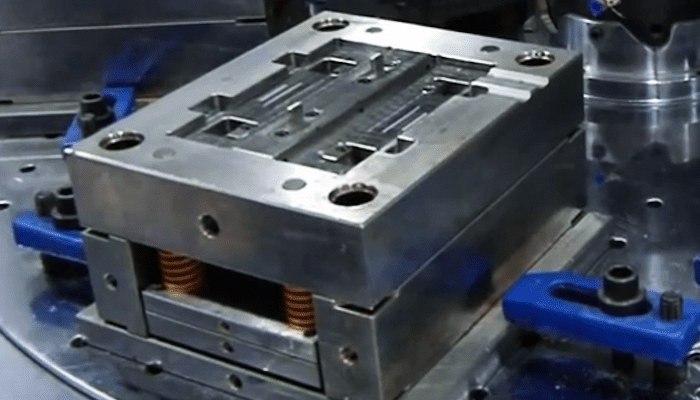The three-plate is also named small gate mold, with an additional mold plate between the cavity and top clamp plate. This supplementary plate is called a runner plate. It allows the plastic molded parts and the runner scrap to release separately.
The three plate mold construction is divided into three distinct plate structures that separate from each other after opening. One opening provides the sprue ejection and clearance, while the other opening allows release for component ejection. Being a tool of increased complexity, the three plate mold is expensive and time-consuming to manufacture. Its three main groups are Fixed Cavity, Movable Side (core plate), and Runner Stripper Plate.
Advantages Of The Three Plate Mold
Three-plate mold is capable of high volume production because of its more huge injection molding machine. Let me explain all the other advantages of this mold.
- Flexibility in gate location
- Gate removal operation is excluded
- Budget-friendly substitute to hot runner mold.
- Less likely to break down than a hot runner mold.
- Thermally sensitive things are less likely to degrade.
- Easy to remove because three plate mold uses pinpoint gate.
- Highly suitable for automation, as runner and product can be removed separately.
- Good appearance and high-precision are possible.
- No short-shot problem, as the molten plastic’s flow is good.
Disadvantages Of The Three Plate Mold
This mold has a complex structure, more problematic, and less durable. Before you decide to go for a three-plate mold, don’t forget to read its disadvantages.
- Long cycle time than two-plate mold.
- Complex mold structure
- Mold repair and design are expensive.
- Not a budget-friendly option for low quantity
- Consumes more materials
- High pressure is required for injection
The Structure of Three Plate Mold
Typically, mold is divided into three main parts; a runner stripper plate is added between the cavity plate and the top clamping plate. Let’s have a look at the critical components of the three plate mold in detail.
- Locating Ring: this is a circular component fitted on the mold’s face over the sprue bush. Its function is to find the mold in the correct position in the mold injection machine. It also ensures the proper alignment between the sprue bush and the nozzle and prevents leakage as well.
- Dowel Pin: these precisely shaped pins are used to keep machine components in an accurate position. These are also used as location guides for neighboring machine parts to keep them properly aligned.
- Sprue Bush: it provides a pathway between the mold and modeling machine nozzles. A sprue bush includes an opening that connects with a nozzle.
- Guide Pin: this is used to accurately locate the three plate injection mold’s cavity and core side. It also allows the cavity and core to match perfectly and smoothly.
- Cavity Retainer Plate: this plate in a molding machine holds the forces and cavities. Such plates are present at the parting line and consist of bushings and guide pins.
- Core & Cavity: these are the shaped sections on either side of the three mold plates, which give the plastic product its final look. The design of the core & cavity is vital in the correct formation of the plastic product.
- Support Plate: this is the foundation of the three-plate mold, as it is used to supports all the components.
- Spacer Block: this component is mounted between the movable cavity plate and the movable clamping plate to provide space and permit the ejector plate to move when ejecting the part.
- Stop Pin: used to reduce the contact surface between clamping plates and ejector plates. By adjusting the thickness of stop pins, it is easy to control the smoothness of ejector plates.
- Movable Clamping Plate: this plate is used to hold three plate mold’s portable side to the movable platen.
- Ejector Retainer Plate: it holds or locks the heads of ejector pins in place, so they don’t come out during the injection molding process.
- Return Pins: the function of return pins is to push the ejecting plate back.
- Runner Stripper Plate: it is used to push a core and prepare the next shot’s mold. It makes full contact with the outer edges of a fragment, making it a reliable ejection method in injection molding.
How Does The Three-Plate Mold Work?
When a three-plate mold opens, at first, the core and cavity will not separate from each other. It would be best if you split the stripper plate from the cavity plate. In the second step, the stripper plate will release the molded product from the gate material. Finally, the core and cavity will separate from each other to eject the product. The plastic injection molding steps in a three-plate mold machine are Injection, Cooling, and remove products.
The three-plate injection mold consists of two parting lines, three opening sequences; runner opening, a product opening, and a runner stripper plate opening. One parting line is used to remove the product, while another parting line is used to remove a runner.
Let’s have a look at three opening sequences/openings of three-plate mold one by one:
Runner Opening
When mold open, cavity plate or fixed side will slide on support pin by gate cutting spring fore. Gate cutting spring accumulates between the cavity plate and the runner stripper plate. The product will attach to the core plate, and the runner lock pin skips the runner on the stripper plate. Three plate molds usually use a pinpoint gate to make the cutting easy. Mold will run continuously, and the runner opening usually cuts the runner from the product.
Runner Stripper Plate Opening
When the cavity plate moves to the puller bolt’s end, the following cavity plate will be moved by puller bolts. It allows the runner stripper plate’s movement and helps the runner stripper push the runner out of the runner lock pin.
Product Opening
After the opening of the parting lock, the cavity plate and core plate will get separated. The core plate will move continuously, and the cavity plate will stop working. This will create a distance removing the product.
Summary
The three plate mold is best when the part is too large and requires multiple injection points. However, three plate mold is usually not recommended because of the higher scrap rate and lack of stability. It is best to use for high volume productions because of its long time cycle, longer distance, and giant injection molding machine.


